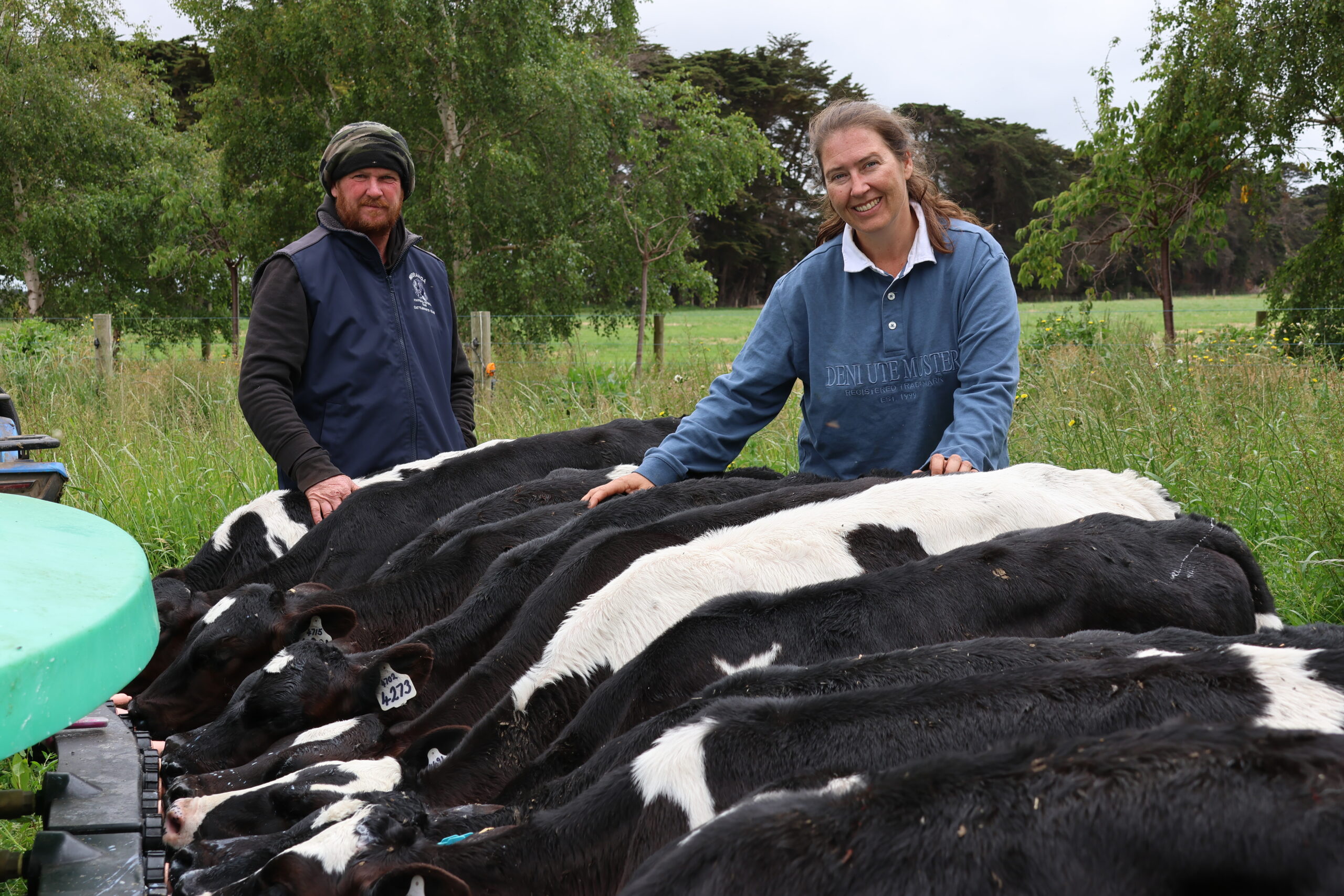Benefits stack-up for genomic testing
Andrew Delaney and Jacqui Cornelissen
Region: South-West Victoria
Topic: Genomics
Andrew Delaney bought a pack of penicillin 16 months ago – he still hasn’t used it all.
For the Nirranda, Victoria, dairy farmer this is just one of the examples of why breeding from his top cows – according to genomics – is providing a return on investment.
This scarcely-used pack of penicillin is a cost saving, while an average bulk milk cell count of 80,000-90,000 cells/mL ensures maximum value is achieved for milk.

Genomics and the use of sexed semen from high BPI bulls have helped Andrew Delaney and Jacqui Cornelissen improve the genetics of their herd, which ranked 8 for BPI in August 2023.
This is without considering the extra money earned from good protein and fat percentages – the 300-strong herd often records a protein percentage close to four – and big numbers of high Balanced Performance Index (BPI) heifer calves he chooses from as herd replacements.
The Holstein herd owned by Andrew, partner Jacqui Cornelissen and children Beau (13), Jacob (10) and Amelia (9), was ranked 8 on DataGene’s BPI top Holstein herds list with an average BPI of 277 in August 2023.
This ranking is a result of careful breeding decisions – focusing on using high BPI bulls, using sexed semen and genomics to ensure only the best animals are kept as replacements.
For Andrew, genomics is also a practical tool that aids everyday decision-making.
“I’ve got to do it to decide which cattle to sell anyway,” he said.
“Thanks to genomics I can sell them as young calves. Last year I was getting $650 for a week-old calf – why would I want to rear it?
“This year the price has come back and it’s like $150, but I’d take that any day. It (the heifer) isn’t going to make my herd; I don’t want to rear it with the cost of the extra milk they would be drinking, extra pellets to feed them and then the work.”
By now, most of the milking herd is also genomically tested, so genomics also plays a part in determining cull cows.
“If I have 350 (BPI) heifers coming in and cows under 100 BPI, someone has to go,” he said.
“I sold some recently, they had a BPI of 20. They were in the herd for a long time but now I have all these young ones coming through – that are high BPI according to their genomics – when I need to, I clean out the older cows.”
Andrew started genomic testing heifer calves almost eight years ago to objectively determine the genetically superior animals.
His confidence in the technology grew when his first genomic samples and a recent herd test “married up”.
For example, a cow with a low herd test was the mother of a calf with a low BPI – indicated by its genomics.
Years later, Andrew’s motivation for taking ear notch DNA samples from calves has remained the same, but thanks to a business decision to breed exclusively with sexed genetics, it’s become increasingly important.
Andrew and Jacqui have two customers for their week-old dairy heifer calves that don’t make the cut as replacements to rear on-farm.
Genomics ensures they retain the highest BPI heifers and those that fit the farm’s breeding objective.
In recent years, Andrew has been concentrating on breeding for chest and body width, teat length and milk. He’s also continued with his long-term breeding goals of improving fat and protein.
These traits and the herd’s BPI are tracked using the DataGene Herd Data app.
Jacqui joked about carrying two phones down the paddock – the older of the pair runs the farm apps – but the practicality of having data on-hand overrides any inconvenience.
She said they’d often check the BPI of cows as they calve, in anticipation of what’s to come.
It’s this eye on the future – and a desire to continually progress – that drives Andrew and Jacqui.
They are reaping the benefits now of using data and anticipate breeding – and especially BPI – to play a factor in the herd’s value and future marketing opportunities.
“In the future it will be a good way to sell your cattle,” Andrew said.
“Also, sooner or later I’ll be selling milking cattle – high genomic cattle – to other farmers. They are not going to be in our herd, but they will be good cows for someone else, good cows wherever they go. As genomics gets more and more popular, and more people test their cows, they will see the differences between a high genomic herd and a low genomic herd and what that looks like. If they are going to invest, why not invest in a higher genomic herd, with a higher BPI behind them?”


